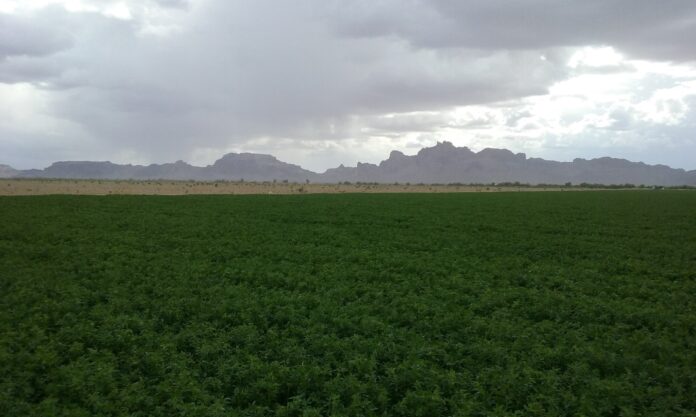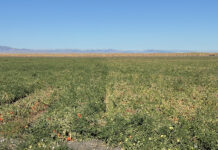Forage crops represent a broad group and include crops specifically grown to be grazed on by livestock or conserved in some manner for later use (e.g., alfalfa and silage corn for this article). Forage preservation practices include the baling of hay or storing the forage under conditions that help prevent decomposition (e.g., silage). Although Western U.S. agriculture is famous for the production of tree nuts, citrus, wine grapes and vegetable crops, forage crops are also high on the list with Arizona and California growers consistently producing both high yields and high quality relative to national averages. In fact, the state of California alone has over 2 million acres of irrigated alfalfa and other forage crops spread across the state in multiple growing regions. A 2018 study estimated California alfalfa hay growers harvested 980,000 acres with a production value of $769.8 million. Additionally in 2018, California alfalfa hay was ranked as the state’s 11th most valuable commodity. Forage production remains a major crop category in Arizona as well, often ranking as the top five crops in several growing regions (Figure 1). In short, forage crops are a big deal!


Nutrient Needs for Silage Corn and Alfalfa
A unique characteristic of forage crops, relative to other crops, is the entire aboveground mass of stems, stalks, leaves, grain, etc. is harvested. As a result, large quantities of nutrients are exported off the field during a typical harvest (Figure 2). For most crops, only a portion is harvested (e.g., nut, fruit piece, cob, pod, etc.) and most of the plant remains behind on the field. Imagine if we removed the entire tree each time we harvested citrus? Sounds ridiculous, but whole-plant harvest for forage crops dictates a nutrient management plan that can 1) support the tremendous forage crop yields we can generate in Arizona and California and 2) replace the nutrients that were exported off the field to maintain long term soil fertility.
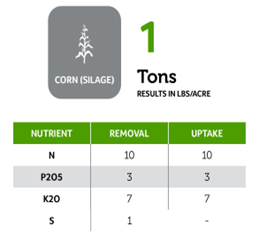
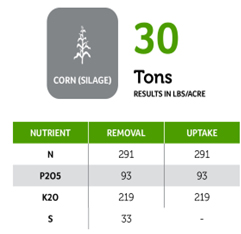
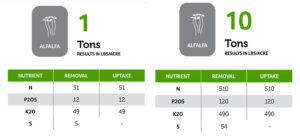
How Much NPK Do I Need?
Nutrient uptake and removal rates for high-yielding forage crops can be jarring to those unaccustomed to triple-digit export numbers. If improperly fertilized, forage crops may not hit estimated yield and quality goals, and subsequent soil fertility will decrease for the next crop in the rotation. However, there are many tools available for forage crop growers and their consultants to use to help match mineral fertilizer needs (e.g., urea, monoammonium phosphate, muriate of potash, etc.) and manage costs (Figure 3).
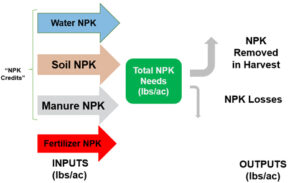
A suite of soil and water tests can help determine what ‘free’ nutrients may already be available to the crop, and a good manure sample can be invaluable for determining exactly what was applied on the field as many forage cropping systems are near diaries, egg laying and broiler operations, and cattle feedlots. Manure can be a crucial source of NPK for forage crops, but lab tests are needed to help estimate NPK input rates (lbs/ac) given the observed ranges seen across the manure spectrum (Table 1). Upon quick inspection of the report, NPK ranges for each manure type will reveal how simple assumptions can quickly promote the development of underfertilized or overfertilized fields. Why the broad range? Manure are tricky as the NPK content can be impacted by animal species, diet, housing and bedding, manure storage and handling system, weather impacts on animals, etc.

Now that we know our various nutrient needs and have accounted for the NPK in the water, manure and soil, we can get a better estimate for what mineral fertilizer needs remain to drive optimal crop yields.
Total crop uptake (lbs/ac)
– Nutrients delivered in water (lbs/ac)
– Nutrients in soil (lbs/ac)
– Nutrients provided by manure application (lbs/ac)
= Nutrients needed by fertilizer program (lbs/ac)
Notes on Legumes, N Fixation and Fertilizer Programs
Nitrogen
Alfalfa production has a long history in Arizona and California, and its unique ability to ‘fix’ nitrogen and make its own N fertilizer is worth mentioning. This N fixation capacity (lbs N/ac) is a crucial part of the overall fertilizer budget for alfalfa. Due to the relationship between the crop and N-fixing bacteria, one might assume the plant does not need any additional N fertilizer to fuel crop growth (Table 2).
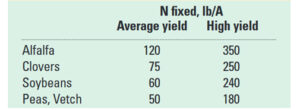
However, this assumption is not valid as it does not recognize the temporal dynamics inherent to the development of optimal rates of N fixation (Marschner 2012). High-yielding legume crops may need supplemental N fertilizer inputs to drive growth at a few key stages (Figure 4).
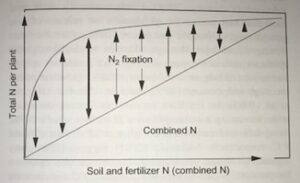
This includes early seedling stages when the N fixation relationship is not yet optimized and in later stages when crop growth rate is demanding N at a rate where fixation cannot keep up (Peoples et al. 1989). Care must be taken when trying to supply alfalfa crops with extra N fertilizer as the fixation process is sensitive to excess N in the soil. The traditional set of tests (manure, water and soil) can help determine if additional N is needed for alfalfa production.
Phosphate
The role of phosphorus in crop production is well established, and P also plays a key role in promoting N fixation. Under low P supply conditions, P deficiency limits plant root growth and the creation of ATP (biological currency) used to build sugars. Remember the critical relationship between plants and N fixing bacteria: No sugar equals no carbohydrates to pay for N fixation. In a study, Cassman et al. (1980) show that by increasing the P supply to a soybean crop, they were able to increase both root and nodule weight. This, in turn, drives an increase in aboveground yield as measured by shoot dry weight (Table 3).
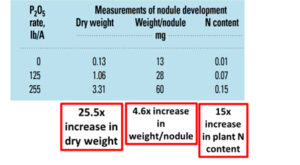
Potassium
In general, potassium has been shown to increase rates of N fixation and overall yields via the following mechanisms (Better Crops 1998). K contributes to good root growth and has been shown to improve the number and size of nodules on roots. K serves as a cofactor for the action of an enzyme needed to transport carbohydrates across cell membranes and into the phloem. Remember the critical relationship between plants and N-fixing bacteria: No sugar equals no carbohydrates to pay for N fixation. In a study, Better Crops (1998), showed by increasing the K2O supply to a soybean crop, they were able to increase both nodule number and nodule weight. This, subsequently, led to an increase in aboveground yield and seed protein quality (Table 4).

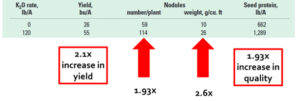
Forage crop growers are facing multiple challenges including volatility in fertilizer prices, supply and logistics bottlenecks, and water supply constraints among others. These challenges come at a time characterized by a tandem increase in demand for animal-based products such as dairy, eggs and meat as well as a stricter regulatory environment. Proper nutrient management will help optimize the yield, quality and profitability of forage crops and help meet future demand for nutritious food. Furthermore, proper accounting and application of NPK from both manure- and mineral fertilizer-based sources will help prevent losses to the environment and ensure that regulatory conditions are met. Working with an experienced crop advisor can clarify the various sample reports (e.g., manure, water, soil tests), estimate total NPK uptake needs and, finally, help develop a sound nutrient management plan that meets the criteria of an increasingly complex production environment.
Resources
Better Crops/Vol. 82 (1998, No. 3) – LXXXII (82) 1998, No. 3 (ipni.net)
Better Crops/Vol. 83 (1999, No. 1) – LXXXIII (83) 1999, No. 1 (ipni.net)
Minnesota Extension Service – Manure Characteristics (umn.edu)
Understanding the Role of NPK in Promoting N Fixation in Legume Crops | Helena Agri-Enterprises, LLC
Alfalfa & Forage Industry – California Alfalfa & Forage Association (calhay.org)











